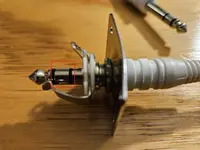famous beagle
Well-known member
I have a few older units in my rack and can't find info in the manuals about whether or not the 1/4" connections are balanced or unbalanced. I was hoping I could find an easy way to tell without having to open them up (I'd have to take them out of the rack), and I saw this on a forum:
====================
"One way to verify an unbalanced jack is: put a TRS cable into it. Use multi-meter to check continuity between R and S on the end of the cable.
If there is continuity, it is unbalanced for sure. (if there is not continuity, that does not necessarily prove its balanced, however)"
====================
My question is this: Why would you have continuity between the ring and sleeve? I have a guitar output (TS) jack lying around in my bag of parts, and when I plug a TRS cable into it, nothing is making contact with the ring at all. Only the sleeve and tip are making contact with anything.
When I test for continuity between ring and sleeve, I (as expected) do not get it.
Am I missing something?
The post on the forum was from 2009, so I can't ask the poster for clarification. But I don't see how that would work.
====================
"One way to verify an unbalanced jack is: put a TRS cable into it. Use multi-meter to check continuity between R and S on the end of the cable.
If there is continuity, it is unbalanced for sure. (if there is not continuity, that does not necessarily prove its balanced, however)"
====================
My question is this: Why would you have continuity between the ring and sleeve? I have a guitar output (TS) jack lying around in my bag of parts, and when I plug a TRS cable into it, nothing is making contact with the ring at all. Only the sleeve and tip are making contact with anything.
When I test for continuity between ring and sleeve, I (as expected) do not get it.
Am I missing something?
The post on the forum was from 2009, so I can't ask the poster for clarification. But I don't see how that would work.


